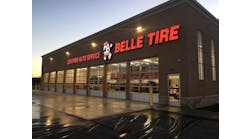For the first six months of 2011, says Dan King, Yokohama Tire Corp. (YTC) senior vice president of sales and marketing, ramifications from the March 11 earthquake and tsunami have challenged YTC.
The disaster devastated parts of Japan, home to Yokohama’s parent company, The Yokohama Rubber Co., Ltd. (YRC), and the company is still recovering. (See Yokohama continues earthquake relief efforts.)
The earthquake, along with a shortage of raw materials, has exacerbated an already tough global fill-rate problem. Despite all, King says Yokohama’s mark of continuous growth is on course, with 2011 showing to be a strong year and the outlook on the future even stronger.
In a recent Q&A he covered the details:
Question: Can you give an update on how the Japanese earthquake and tsunami affected YRC? Also, how has it affected YTC in the U.S.?
Dan King: We all know it was devastating to the country and people of Japan, and it has impacted all the people at YRC to some degree. We’ve been lucky: most of our employees in Japan and their extended family members were not seriously hurt.
We did lose some facilities and witnessed some downtime with a number of our Japanese plants and testing facilities. Not surprisingly, we experienced a shortage of raw materials and products. We tried to minimize the impact in North America – where the demand is so high.
It did have an effect, though, especially within our commercial tire division where we received less inventory than we anticipated. However, we were able to work through it and move forward. We were very fortunate within our consumer tire division as well, as a large portion of demand from there is filled in our plant in Salem, Virginia, which we are currently expanding and will be finished in September.
Question: Do you see any long-term effects?
King: No, we don’t see any issues based on where our plants are in the region. The raw material shortage will last a bit longer, but we don’t see that as a long-term situation.
Question: Supply shortages seem to be an industry-wide problem. Do you see that situation for Yokohama improving in the next six months?
King: The OE segment remains in high demand. With respect to the replacement market – though it is showing a slight leveling off this year – the segment is expected to see industry growth next year, in 2013 and 2014. We expect to see worldwide growth as well, especially in China, India and Brazil. It’s going to have an impact on the industry’s capacities, and we are addressing that with the Salem expansion and a major expansion in the Philippines. We’re looking at other parts of the world, as well.
For Yokohama specifically, we feel very good because our demand is high. We’ve always prided ourselves on working closely with our customers and having very strong fill rates, but we haven’t been able to do that right now. We are increasing our supply and bettering our fill rates, and we expect this to improve even more next year.
Question: Is the Salem expansion on target in production output?
King: It’s definitely on target. We’ve been able to get more production each month than we had originally planned.
Question: We’re midway through 2011. Business-wise, is YTC where you projected?
King: It’s been a good year for Yokohama. We have very strong demand and, as mentioned, our biggest challenge is making sure our customers are taken care of. We’re not always going to be the biggest supplier, but we strive to be the best and most efficient. We want our customers to love selling our product and to have confidence in us. That’s why we’re working so hard to eliminate the fill rate situation.
From an industry standpoint, we saw growth in the first couple of months of the year, but we’re now starting to see it trail off. We have to watch consumer demand closely because as gas prices increased, we saw a pullback. The economy is still a concern for consumers.
Question: Is the presence of cheaper tires from China and other countries still a factor?
King: There are a lot of brands in the U.S. It’s a large and growing market, so a lot of manufacturers want to have a presence here. However, the raw material cost increases have been significant, and those impact every manufacturer, including the Chinese. They’ve had to re-evaluate how they price in the U.S. There have also been issues with duties – the Chinese and Thailand tariffs. Those have had an impact on pricing in the U.S., as well.
For the complete Q&A, click here.



